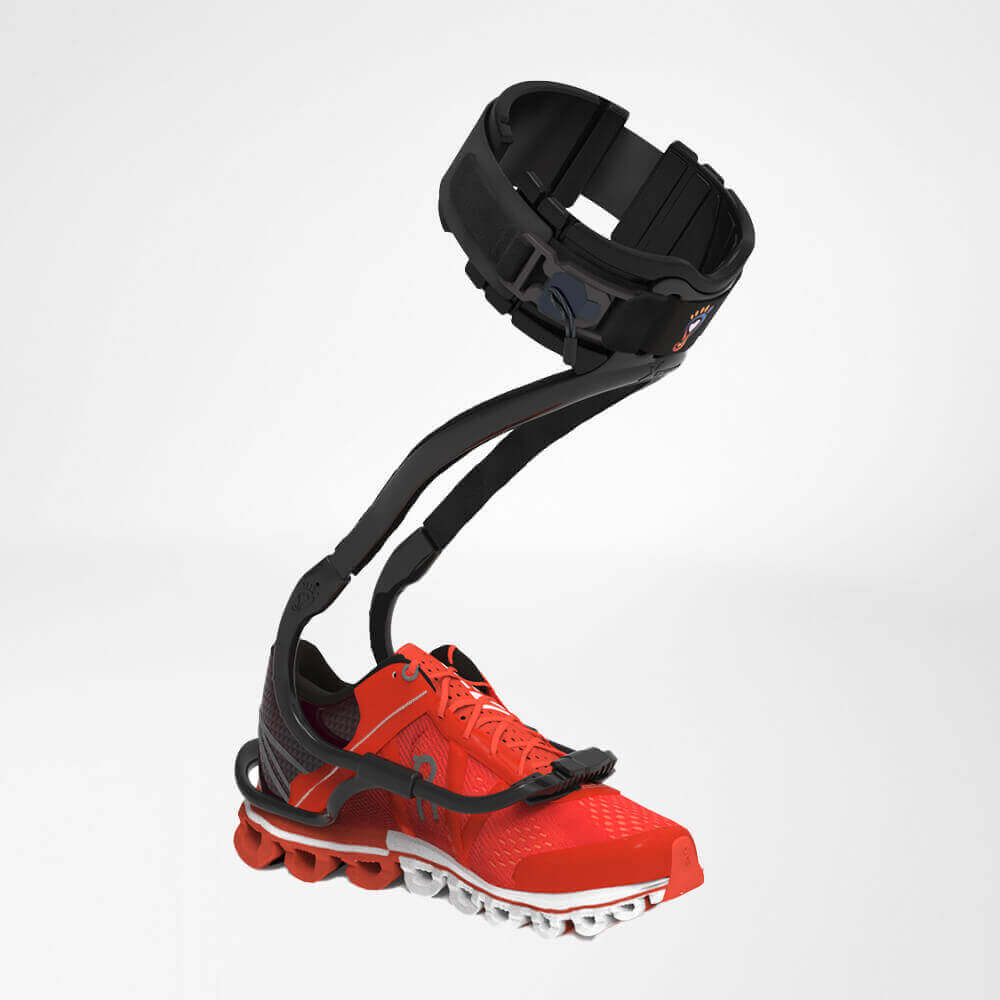
Weakness of the dorsiflexion of the foot
Causes, symptoms, diagnosis, and treatment
The condition known as foot drop, or more correctly weak dorsiflexor muscles, is not just annoying and can represent a dangerous trip hazard, but it also changes the gait. This can result in inappropriate mechanical stress and incorrect posture in the long term. Simple movements, such as walking over minor obstacles, may no longer be possible. This often causes a justified fear of falling during everyday activities. Find out in this article how you – supported by the right product – can easily walk, run, and even hike in your own sneakers, boots, as well as sandals without having to worry.
What exactly are weak dorsiflexor muscles?

You will be suffering from weak dorsiflexor muscles if the muscles that are responsible for lifting your foot and toes have been weakened or are restricted because of paralysis. As a result, controlling the foot position or lifting the foot during walking will no longer work properly. This means that your foot hangs down in a way, becoming a trip hazard.
This often causes serious impediments during walking, frequent stumbling, dragging the affected foot behind you, or limping. This gait common for weak dorsiflexor muscles is also known as “stork walk”. That’s why foot drop is also associated with an increased risk of falling and subsequent injuries. Walking movements are impaired because of foot drop. Posture will therefore become unnatural (posture to help relieve pain), frequently accompanied by subsequent damage for example to the knee, hip, or back.
Symptoms and problems in cases of weak dorsiflexor muscles
Symptoms and problems in cases of weak dorsiflexor muscles vary depending on severity and cause. A signature sign is that the foot and toes can no longer be lifted properly (foot drop). This makes walking much harder. When crossing obstacles in particular, weak dorsiflexor muscles will generally cause difficulty.
Weak dorsiflexor muscles lead to significant restrictions during everyday activities, such as taking the stairs, walking, or exercising, and to an increased risk of accidents. The most common symptoms include:

What can cause weak dorsiflexor muscles?
The cause of weak dorsiflexor muscles is usually damage to muscles or nerves that control the dorsiflexor muscles. This damage can be advanced by various triggers. The most common include:
- Neurological disorders, such as stroke, multiple sclerosis, Guillain Barré Syndrome, amyotrophic lateral sclerosis (ALS), and polyneuropathy often result in weak dorsiflexor muscles in one foot or both feet. A common cause is dorsiflexor paresis, which is also known as peripheral nerve paralysis of the dorsiflexor that is controlled by the peroneal nerve.
- During injuries caused by accidents in the area of the ankle, lower leg, or spine – for example during a fall with a bicycle or motorbike – nerves, tendons, and muscles can be damaged that control the dorsiflexor. The same applies to inflammation. In the same way, an intervertebral disk prolapse in the lumbar spine can damage the nerves that control the dorsiflexor, which can result in weak dorsiflexor muscles.
- Inactivity and a lack of exertion, because of extended bed rest for example, can also be problematic. If the muscles are not subjected to enough strain, they can atrophy, potentially resulting in weak dorsiflexor muscles. Age-related changes and degeneration of the nerves or muscles can also lead to weak dorsiflexor muscles.
- Furthermore, drugs like chemotherapeutics, in particular those that have polyneuropathy as a side effect, can cause weak dorsiflexor muscles.
- In rare cases, weak dorsiflexor muscles can also be caused by genetic factors.
- And then there’s a condition known as idiopathic weak dorsiflexor muscles where science has not yet found the cause.
The treatment for weak dorsiflexor muscles will depend on the identified cause. It should therefore be accurately determined by a thorough clinical neurological examination.
Suspecting weak dorsiflexor muscles? Better see a physician!
Weak dorsiflexor muscles are usually a symptom of a deeper problem. If you suspect that you may have weak dorsiflexor muscles because you have noticed symptoms, you should not hesitate and visit a physician so you can get the relevant diagnosis. During early stages, therapeutic action can often halt the progression of the condition and even achieve long-term improvement.
But only a physician can provide you with a definitive diagnosis and start appropriate treatment. If weak dorsiflexor muscles remain untreated, they will, sooner or later, lead to complications and seriously impact quality of life. Additionally, over time, the risk of falls, injuries, and subsequent damage will increase.
How are weak dorsiflexor muscles usually identified by a physician?

In any case, identifying weak dorsiflexor muscles requires a thorough physical examination as well as further diagnostic tests, if required, which are usually carried out by a neurologist. An in-depth medical history is taken to begin with. This is designed to gather information about symptoms, previous injuries or conditions, and the progress of your problems.
After that, the physician will generally examine you to check muscle function, reflexes, and the sensitivity as well as mobility of your foot and lower leg. The physician will also often do a gait analysis. Your gait can then be assessed, and anomalies during walking can be detected.
In addition, the physician can also perform various neurological examinations to check the function of your nerves and muscles in the area of the dorsiflexor. This includes reflex tests, muscle strength tests, perception tests, and coordination tests. If required, a neurologist can perform electroneurography (a diagnostic procedure used to assess the electrical activity of muscles and nerve function). This can help determine whether you have nerve damage and how serious it is.
In certain cases, the physician will take X-ray images, magnetic resonance imaging (MRI), or use computer tomography (CT). In this way, potential structural anomalies or injuries in the area of the foot, lower leg, or spine can be identified which may cause weak dorsiflexor muscles.
At the end, your physician will provide you with your diagnosis based on the results of these examinations and recommend appropriate treatment.
Treatment and therapeutic action

In order to ensure you can walk again immediately and naturally, and as a supporting feature of the treatment arranged by your physician, the Xtern Summit and Xtern Frontier ankle foot orthoses are recommended, which have been specifically developed for the indication of weak dorsiflexor muscles. Both are listed in the Statutory Health Insurance Medical Aids Directory.
These state-of-the-art dynamic ankle foot orthoses can be attached from the outside to practically any shoe. Therefore, they don’t usually rub or cause discomfort. You will not be restricted when walking and you can go through life without worrying. That’s particularly important because the major part of treating weak dorsiflexor muscles consists of regular physiotherapy, i.e. consistent exercise and practice.
Instead, the orthosis lifts your foot automatically to its natural position, allowing you to largely walk naturally from the very first step. This orthosis for weak dorsiflexor muscles therefore makes sports or hiking across uneven terrain possible again.

Of course, your medical treatment will depend on the results of your examinations and the specific causes of your weak dorsiflexor muscles. This means that, in individual cases, the elimination of unfavorable conditions, for example changing work activities with supporting physiotherapy, may even suffice.
Nevertheless, specific drugs and treatment methods are available to the physician in charge. Surgical procedures or a combination of different methods may also be beneficial.
Always remember: the sooner you do something about your weak dorsiflexor muscles, the more likely it is that you’ll be able to avoid permanent restrictions in functionality and subsequent damage.


